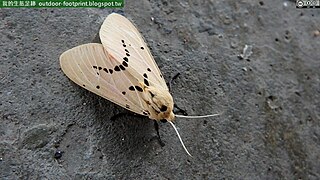
Axia, the gold moths, is a genus of moths whose precise relationships within the macrolepidoptera are currently uncertain, but they currently are placed within the superfamily Drepanoidea. Uniquely, they have a pair of pocket-like organs on the seventh abdominal spiracle of the adult moth which are possibly sound receptive organs. They are quite large and brightly coloured moths that occur only in southern Europe and feed on species of Euphorbia. Sometimes they are attracted to light. The genus was first described by Jacob Hübner in 1821.

Eriogaster is a genus of moths in the family Lasiocampidae first described by Ernst Friedrich Germar in 1810.

Creatonotos is a genus of tiger moths in the family Erebidae. The moths in the genus are found in the Afrotropics, South and East Asia, Sundaland and Australia.

Manulea is a genus of moths in the family Erebidae erected by Hans Daniel Johan Wallengren in 1863. The type species is Lithosia gilveola Ochsenheimer, 1810.
Maurica is a genus of moths in the family Erebidae from north-western Africa. The genus was erected by Josef J. de Freina and Thomas Joseph Witt in 1984. Originally one species more was included into the genus, M. bellieri(Lederer, 1855) from the Near East; but later it was returned into the genus Ocnogyna.
Oroncus is a genus of tiger moths in the family Erebidae.

Paidia is a genus of moths in the family Erebidae erected by Jacob Hübner in 1819.

Watsonarctia is a monotypic moth genus in the subfamily Arctiinae erected by Josef J. de Freina and Thomas Joseph Witt in 1984. Its only species, Watsonarctia deserta, the chaste pellicle, was first described by Max Bartel in 1902. It is found in central and south-eastern Europe, southern Russia, southern Siberia east to Lake Baikal; also in Asia Minor, Armenia, Azerbaijan, northern Iran, Kazakhstan, Kyrghyzstan and Xinjiang in China.

Setina is a genus of moths in the family Erebidae.

Spilarctia is a genus of moths in the family Erebidae. The genus was erected by Arthur Gardiner Butler in 1875.

Stoermeriana is a genus of moths in the family Lasiocampidae described by Josef J. de Freina and Thomas Joseph Witt in 1983.
Heterogynis is a genus of moths of the Heterogynidae family.
Lithosarctia hoenei is a moth of the subfamily Arctiinae. It was described by Franz Daniel in 1954. It is found in Yunnan, China.
Lithosarctia goergneri is a moth of the family Erebidae. It was described by Josef J. de Freina and Thomas Joseph Witt in 1994. It is found in Gansu, China.
Lithosarctia thomasi is a moth of the family Erebidae. It was described by Josef J. de Freina and Thomas Joseph Witt in 1994. It is found in Tibet, China and Nepal.
Oroncus weigerti is a moth of the family Erebidae. It was described by Josef J. de Freina and Thomas Joseph Witt in 1985. It is found in northern Pakistan (Karakorum).
Paidia elegantia is a moth of the family Erebidae. It was described by Josef J. de Freina and Thomas Joseph Witt in 2004. It is found in southern Iran.
Setina cantabrica is a moth in the family Erebidae. It was described by Josef J. de Freina and Thomas Joseph Witt in 1985. It is found in Spain.
Semagystia is a genus of moths in the family Cossidae.
Eremocossus is a genus of moths in the family Cossidae first described by George Hampson in 1893.








